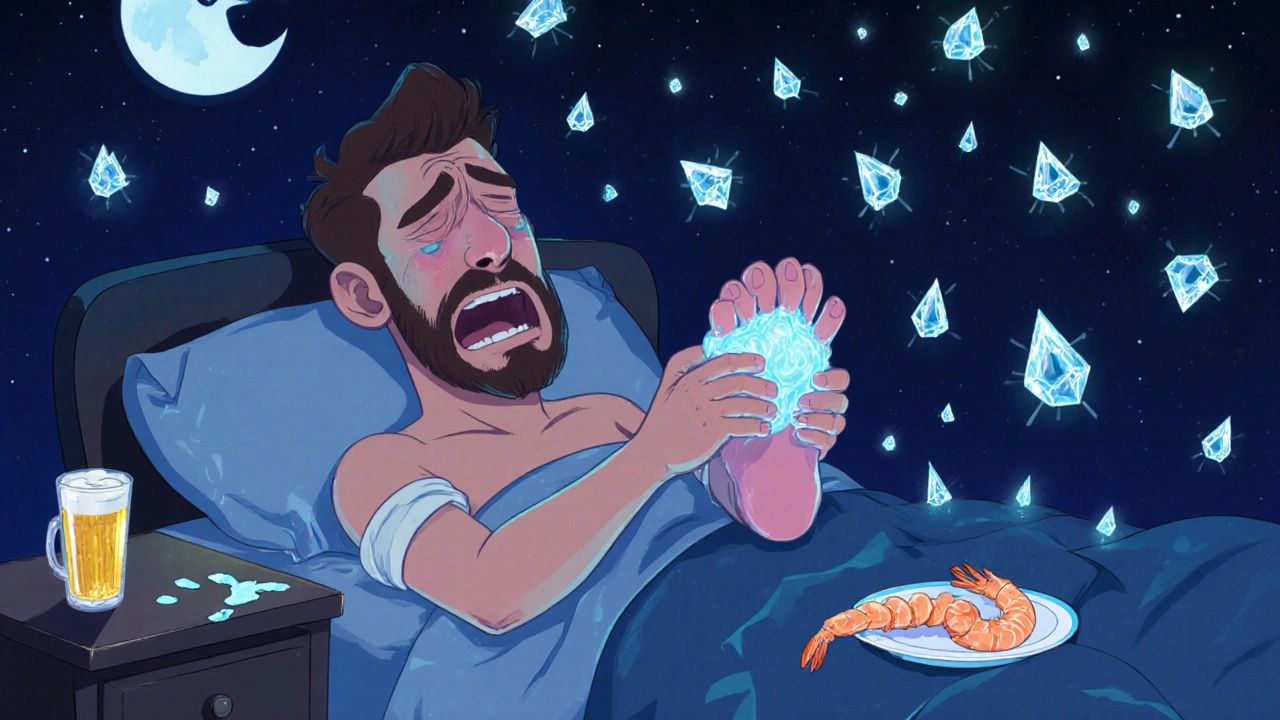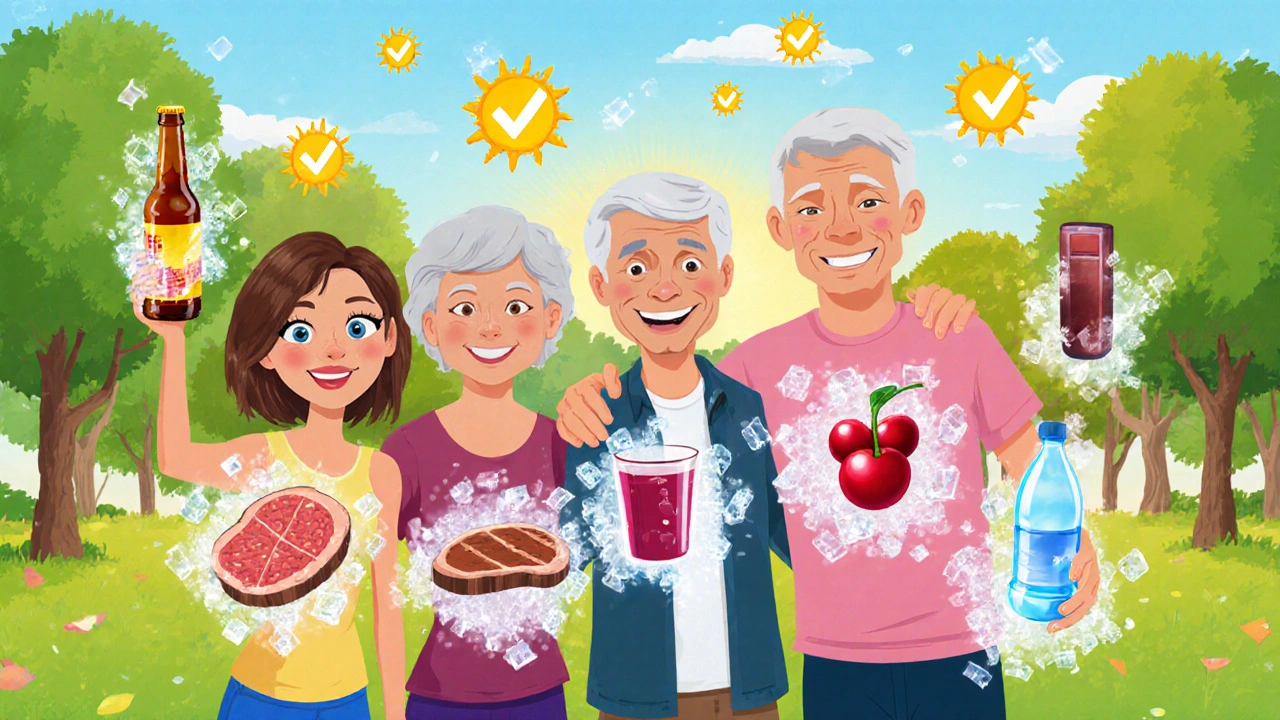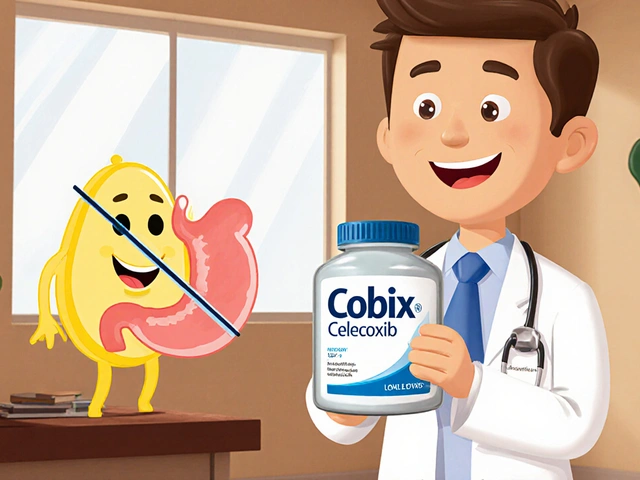
When your big toe suddenly swells up so badly you can’t even wear a sock, and it feels like someone’s crushing it with a hammer, you’re not imagining things. That’s gouty arthritis - and it’s more common than most people think. It doesn’t just affect older men who drink too much wine. Women, younger adults, and people with no obvious lifestyle risks get it too. The pain hits fast, hits hard, and leaves you wondering what just happened. The good news? You don’t have to live with it. Understanding what causes gout, how to spot it early, and what actually works to treat it can change everything.
What Exactly Is Gouty Arthritis?
Gouty arthritis isn’t just "bad joint pain." It’s a specific type of inflammatory arthritis caused by uric acid crystals sharp, needle-like structures that form when there’s too much uric acid in the blood and deposit in joints. Uric acid is a waste product your body makes when it breaks down purines - substances found naturally in your body and in certain foods. Normally, your kidneys filter it out and you pee it away. But if your body makes too much, or your kidneys can’t keep up, uric acid builds up. That’s when crystals start forming, usually in the big toe, but also in ankles, knees, wrists, and fingers.
This isn’t just a one-time thing. Once you’ve had one flare-up, you’re more likely to have another. Over time, if left untreated, these crystals can damage cartilage and bone, leading to permanent joint changes. That’s why treating gout isn’t just about stopping the pain - it’s about protecting your joints for the long term.
What Triggers a Gout Flare-Up?
Not every high uric acid level leads to gout. But when it does, something usually pushes it over the edge. Common triggers include:
- Drinking alcohol, especially beer and spirits - they interfere with uric acid removal
- Eating large amounts of red meat, organ meats (like liver), shellfish, and certain fish (sardines, mackerel)
- Dehydration - not drinking enough water makes it harder for your kidneys to flush out uric acid
- Sudden weight loss or fasting - this can spike uric acid levels
- Medications like diuretics (water pills), low-dose aspirin, and some chemotherapy drugs
- Stress, illness, or injury - your body reacts by releasing more uric acid
Here’s the thing: you don’t need to be a heavy drinker or eat steak every night to get gout. Genetics play a big role. If your parents or grandparents had it, your risk goes up. And it’s not just about diet. Studies show that even people who eat "healthy" can develop gout if their bodies handle uric acid poorly. That’s why blanket advice like "just eat less meat" often falls short.
How Do You Know It’s Gout and Not Just a Sprain?
The symptoms of gout are unmistakable once you’ve experienced them:
- Sudden, intense joint pain - often waking you up in the middle of the night
- Swelling, redness, and warmth in the affected joint - the skin can look shiny and stretched
- Limited movement - you can’t bend the joint without agony
- Symptoms that peak within 24 hours and may last days or weeks
The big toe is the most common site - about 75% of first attacks happen there. But gout can strike anywhere. Some people get it in both knees at once. Others notice it in their knuckles after a long flight or a weekend of partying. The key sign? It comes out of nowhere. No injury. No fall. Just pain so bad you can’t believe it’s real.
Doctors often diagnose gout by looking at symptoms, checking uric acid levels in blood, and sometimes taking fluid from the joint to look for crystals under a microscope. That’s the gold standard. But even if the blood test comes back normal during a flare, it doesn’t rule out gout - uric acid levels can drop during an attack as your body pulls it into the joint.

What Treatments Actually Work?
There are two parts to treating gout: stopping the flare and preventing future ones.
Stopping the Pain During a Flare
When a flare hits, you need fast relief. Three main options are backed by clinical evidence:
- NSAIDs - like ibuprofen or naproxen. These reduce inflammation and pain. Avoid aspirin - it can make gout worse.
- Colchicine - a drug specifically designed for gout. Taken early in a flare, it can stop the attack in its tracks. Side effects like nausea or diarrhea are common, but lower doses work well for most people.
- Corticosteroids - either as pills (prednisone) or injected directly into the joint. These are strong and fast-acting, especially if you can’t take NSAIDs or colchicine.
Ice packs and rest help too. Elevate the joint. Avoid pressure. No walking if you can help it. The goal isn’t to power through - it’s to let your body calm down.
Preventing Future Attacks
Once the flare is under control, you need a plan to keep it from coming back. This is where most people fail - they feel better and stop doing anything. Big mistake.
Long-term management usually involves one of two medications:
- Allopurinol - lowers how much uric acid your body makes. Most common first choice. Takes weeks to work, so you’ll still need anti-inflammatories during the first few months.
- Febuxostat - similar to allopurinol but used if you can’t tolerate it. More expensive, but effective.
There’s also probenecid, which helps your kidneys remove more uric acid. But it’s only good if your kidneys are working well - not for people with kidney disease.
Doctors usually start these medications after your second flare, or if you have tophi (visible lumps of crystals under the skin), kidney stones, or joint damage. The target? Keep your uric acid level below 6 mg/dL. That’s the threshold where crystals start to dissolve.
Diet and Lifestyle: What Really Helps?
You’ve heard the advice: avoid shellfish, stop drinking beer, lose weight. But here’s the truth - diet alone rarely cures gout. Still, it matters. Small changes can reduce flare frequency and make medications work better.
Here’s what science says works:
- Drink plenty of water - at least 2 liters a day. Helps flush uric acid.
- Limit alcohol - especially beer and hard liquor. Wine in moderation is less risky.
- Choose low-fat dairy - studies show it lowers gout risk.
- Eat more vegetables, even those high in purines (like spinach or mushrooms). Unlike meat, plant purines don’t raise gout risk.
- Avoid sugary drinks - fructose increases uric acid production. That includes soda, sweetened teas, and fruit juices.
- Manage your weight - losing even 5-10% of body weight can cut flare risk in half.
And yes, cherries. Several studies found that eating cherries or drinking cherry juice reduces flare risk by about 35%. No magic bullet, but a helpful addition.
What Doesn’t Work - and What to Avoid
There’s a lot of misinformation out there. Don’t waste time or money on these:
- Apple cider vinegar - no proven benefit for gout
- High-dose vitamin C supplements - while it may slightly lower uric acid, it’s not enough to prevent flares
- Extreme fasting or detox diets - these can trigger attacks
- Ignoring early signs - waiting until it’s unbearable means more damage
Also, don’t stop your medication just because you feel fine. Uric acid crystals take months to dissolve. Stopping treatment too soon is the #1 reason gout comes back.

When to See a Doctor
You don’t need to wait for a second flare. If you’ve had one episode of sudden, severe joint pain - especially in the big toe - see a doctor. Get a proper diagnosis. Don’t assume it’s just a sprain or arthritis.
Also see a doctor if:
- Flares are getting more frequent or lasting longer
- You notice lumps under your skin near joints (tophi)
- You have kidney stones or trouble urinating
- You’re on medication but still having flares
Early treatment prevents long-term damage. Gout is one of the few arthritis types that can be fully controlled - if you act.
Living With Gout - It’s Manageable
Gout used to be called the "disease of kings" because it was linked to rich diets. Today, it’s the most common inflammatory arthritis in adult men and rising fast in women, especially after menopause. But it’s not a life sentence.
With the right treatment plan - medication, lifestyle tweaks, and regular check-ups - most people can live without flares. Some go years without one. The key is consistency. Not perfection. You don’t have to give up every tasty food. You just need to know what triggers you, and how to respond before it spirals.
It’s not about fear. It’s about control. And that’s something you can build - one step, one drink, one pill at a time.
Can gout be cured completely?
Gout can’t be "cured" in the sense that your body stops making uric acid, but it can be fully controlled. With consistent treatment to keep uric acid levels below 6 mg/dL, crystals dissolve over time, and flares stop. Many people live symptom-free for years. The key is sticking with treatment, even when you feel fine.
Is gout hereditary?
Yes. Genetics play a major role. If a close family member has gout, your risk is 2-4 times higher. Certain genes affect how your kidneys process uric acid. Even if you eat well, you might still develop gout if your body naturally produces too much or removes too little.
Does drinking cherry juice help with gout?
Research shows that eating cherries or drinking tart cherry juice can reduce gout flare risk by about 35%. It’s not a replacement for medication, but it’s a safe, natural addition that may help lower inflammation and uric acid levels slightly. A serving of 10-12 cherries or 8 oz of juice a few times a week is what studies used.
Can I still drink alcohol if I have gout?
Beer and spirits are the worst - they significantly raise flare risk. Wine is less risky, but still not safe in large amounts. If you’ve had flares, it’s best to avoid alcohol completely until your uric acid is under control. Once stable, occasional small amounts of wine might be okay, but always check with your doctor.
Why do gout attacks happen at night?
Body temperature drops slightly at night, which makes uric acid crystals more likely to form. Also, dehydration overnight and lower levels of cortisol (a natural anti-inflammatory) can trigger flares. That’s why most attacks wake people up in the early hours.
Is gout the same as rheumatoid arthritis?
No. Gout is caused by uric acid crystals and usually affects one joint at a time, starting with the big toe. Rheumatoid arthritis is an autoimmune disease that attacks joint linings and often affects multiple joints symmetrically (both hands, both knees). Blood tests and joint fluid analysis can tell them apart.
Can gout damage my kidneys?
Yes. High uric acid levels can lead to kidney stones or even chronic kidney disease over time. Crystals can form in the kidneys themselves. That’s why managing gout isn’t just about your joints - it’s about protecting your whole body. Regular kidney function tests are important if you have gout.
Next Steps: What to Do Today
If you’ve had a gout flare, here’s what to do now:
- Write down what you ate and drank before the attack - look for patterns.
- Start drinking at least 2 liters of water daily.
- Make an appointment with your doctor to discuss long-term treatment.
- Don’t wait for the next flare. Prevention starts today.
Gout is not a sign of failure. It’s a signal - your body is telling you something’s out of balance. Listen to it. Act on it. And don’t let fear stop you from living well.







I’ve been telling everyone this for years-gout isn’t just about diet, it’s a pharmaceutical scam to keep you buying allopurinol. Big Pharma doesn’t want you to know that cherry juice and apple cider vinegar can dissolve crystals overnight. They profit off your suffering. I’ve cured my own gout by drinking distilled water with lemon and sleeping on a copper mat. The doctors hate this.
Great breakdown. The key is consistency-not perfection. Drink water, track triggers, take meds if prescribed. You don’t need to be perfect, just persistent. Small steps add up. You got this.
One cannot help but reflect upon the ontological implications of gout as a metaphysical manifestation of systemic imbalance. The uric acid crystal, in its crystalline formation, is not merely a biochemical anomaly-it is the corporeal embodiment of societal neglect toward metabolic harmony. The body, in its wisdom, rebels not from excess, but from dissonance. To treat gout as a disease of the joint is to mistake the symptom for the soul’s cry.
Perhaps the true cure lies not in pharmaceuticals, but in the reintegration of the self with the rhythms of nature, the circadian, the dietary, the spiritual. The modern world, in its haste, has severed this bond-and gout is its elegy.
Uric acid crystallization = purine overload + renal inefficiency + epigenetic predisposition. Allopurinol = XO inhibition. Febuxostat = non-purine analog. Probenecid = URAT1 antagonist. Don’t confuse correlation with causation. The data is clear: target <6 mg/dL. No exceptions.
They say it’s genetics-but what if it’s the water? The fluoridated, chlorinated, government-controlled water supply? They add chemicals to make us sick so we need more pills. I’ve seen it. My cousin in Delhi got gout after the new water plant opened. Coincidence? I think not. The same people who gave us 5G and vaccines are behind this. Wake up.
Oh, so now it’s ‘manageable’? That’s what they said about diabetes. And now look-whole generations on insulin. Gout is just the gateway drug to lifelong pharmaceutical dependency. They’ll tell you to eat cherries, then charge you $500 for a bottle of ‘gout relief’ extract. The real cure? Stop trusting doctors. Stop trusting science. Your body knows better.
I stopped all meds. Ate only raw meat. No water. Just whiskey. Flare? Never again. Because I refused to play their game.
Allopurinol is overprescribed. You’re not a patient-you’re a revenue stream. If you’re not overweight, not drinking, not eating shellfish-and still got gout? You’re genetically defective. Your kidneys are broken. Stop blaming food. Fix your biology or accept the pain. No one owes you a pain-free life.
fruits r bad for gout? no way. i read on a forum that citrus makes it worse. but then i saw a study that says cherry juice helps. so i dont know. maybe its the sugar? maybe its the conspiracy. my doc says take allopurinol. i say maybe i should just drink more water. or maybe i should move to the mountains. idk anymore.
Let me tell you something-this isn’t just about uric acid! This is about the decline of Western civilization! We’ve traded real food for processed garbage, real movement for sedentary screens, real medicine for corporate pills! Gout is the immune system screaming: ‘We are not animals! We are not lab rats!’ You want to beat it? Eat like your ancestors. Walk like your ancestors. Stop swallowing the lies of Big Pharma and the FDA! America is being poisoned-and gout is the canary in the coal mine!
One thing I’ve learned from managing my own gout: community matters. I joined a support group. We share meal plans, medication tips, even just vent about how hard it is to say no to steak. You’re not alone. And you don’t have to suffer in silence. Reach out. Ask for help. It’s not weakness-it’s wisdom.
They say drink water… but what if the water is poisoned? What if the government’s been adding uric acid enhancers to the tap since 2012? I checked the CDC database-there’s a spike in gout cases right after the new water treatment law passed. Coincidence? I don’t think so. I stopped drinking tap water. Now I collect rainwater. And I haven’t had a flare in 18 months. They don’t want you to know this.
Allopurinol is a Band-Aid on a bullet wound. The real issue? The industrialization of the human metabolism. Purines aren’t the enemy-corporate agriculture is. Feedlots. High-fructose corn syrup. Synthetic additives. Your body wasn’t designed to process this. Gout is the body’s protest. Medication suppresses the symptom. But the revolution? It’s in the soil. Eat real food. Grow your own. Or die quietly.